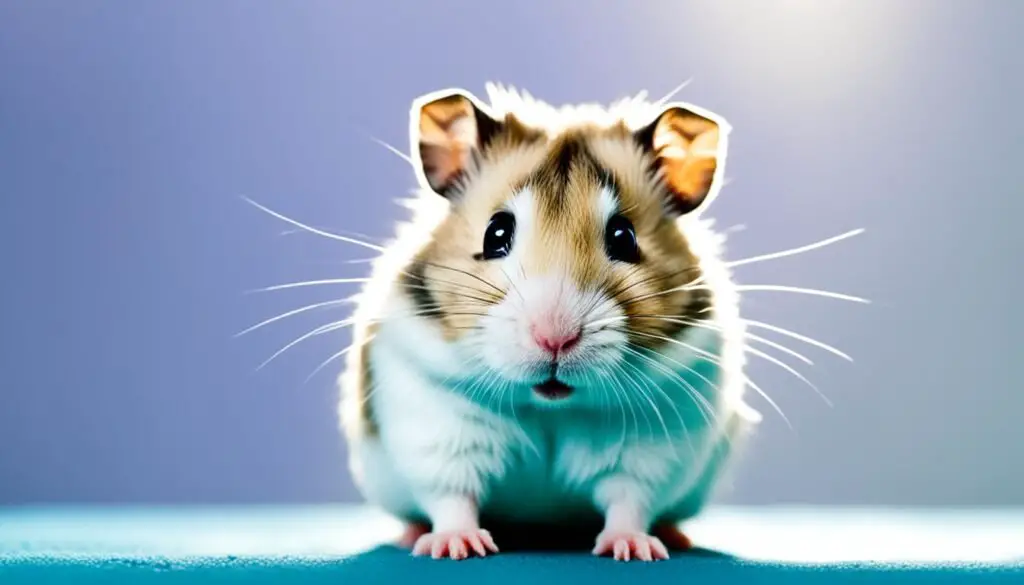Did you know that hamsters are colorblind? Unlike humans who perceive a wide spectrum of colors, hamsters have a limited color perception and see the world in black, white, and shades of gray. But that’s not all! Hamsters also have an interesting ability to detect subtle tones of green and blue, adding a touch of color to their otherwise monochromatic vision.
Hamsters have more rod-shaped cells in their eyes, which allow them to see in low-light conditions and have better night vision compared to humans. Their visual world may be devoid of vibrant hues, but they rely on their acute senses, such as hearing and smell, to navigate their surroundings.
So, how do hamsters really see the world? Let’s delve into their fascinating visual perception and understand the unique way they experience their environment.
How Do Hamsters See?
Hamsters have poor eyesight and are considered near-sighted. Their eyes are made up of 97% rod cells and only 3% cone cells. This composition limits their ability to see colors and perceive details.
Hamsters have a limited color perception and can only differentiate between subtle tones of blue and green. They cannot see any shade of red. Their visual perception is primarily focused on movement and light intensity rather than color.
Hamsters rely on their other senses, such as smell and hearing, to navigate their environment. They have better night vision due to the higher number of rod cells in their eyes, which help them see in low light conditions.
Hamsters have a very narrow field of vision and can only see a few inches past their nose. This limited visual range makes it important to approach them slowly and give them cues when interacting to avoid startling them.
Hamster Color Perception
Due to their poor eyesight and limited color perception, hamsters rely more on their other senses to navigate their surroundings. While they can recognize subtle tones of blue and green, they cannot see colors like humans do.
Hamsters have a unique way of perceiving the world, where movement and light intensity play a more significant role than color. Their reliance on senses like smell and hearing helps them recognize objects and identify their surroundings.
Understanding the visual limitations of hamsters can help us create a safe and enriching environment that caters to their unique needs.
Do Lights Affect Hamsters?
If you’re a hamster owner, you may be wondering if lights have any impact on your furry friend’s vision and well-being. Let’s dive into the fascinating world of hamster eyesight and explore the relationship between hamsters and light.
Hamsters are known for their sensitivity to light and their preference for dim or low light environments. In fact, they have better vision in low light conditions and can see best during dawn and dusk. Bright lights, such as sunlight or spotlights, can be blinding for hamsters and cause them stress and discomfort.

To ensure your hamster’s comfort, it’s important to provide them with dark places to hide and sleep. Avoid exposing them to bright lights that can be overwhelming for their sensitive eyes. By creating a calm and dim environment, you’ll be promoting your hamster’s natural instincts and well-being.
It’s worth noting that hamsters do not need a nightlight to find their way around. In fact, they are naturally adapted to navigate their surroundings without additional light sources. By placing their cage in a position where they can follow their natural day-night cycle, you’ll be supporting their instinctual behavior and promoting a healthy environment.
Hamsters primarily rely on their other senses, such as smell and hearing, to navigate and explore their surroundings. Their olfactory and auditory senses are highly developed, allowing them to compensate for their limited eyesight. Minimizing loud noises in your hamster’s environment is important, as they have sensitive hearing.
In conclusion, hamsters are sensitive to light and prefer dim or low light environments. They have better vision in low light conditions and can see best during dawn and dusk. Bright lights can be blinding and stressful for hamsters, so it’s important to provide them with dark places to hide and sleep. By creating a calm and dim environment, you’ll be supporting your hamster’s natural instincts and well-being.
Can Hamsters Recognize Colors?
Hamsters have a unique way of perceiving the world around them that differs from our own. Unlike humans, who can see a wide spectrum of colors, hamsters are colorblind. Their visual perception is limited to black, white, shades of grey, and some subtle tones of blue and green. They have a higher percentage of rod cells in their eyes, which allows them to see better in low light conditions but limits their color sensitivity.
While hamsters cannot see colors like humans do, they rely on their other senses, such as smell and hearing, to recognize their surroundings and identify objects. It’s fascinating to observe how they can still develop a recognition of their owners through scent and sound. For example, a hamster may associate the scent and voice of their owner with positive experiences, like receiving food or gentle handling. As a result, they may come out of their burrow or hideout when their owner enters the room. This demonstrates their ability to make connections between different sensory cues.
Hamsters have a keen sense of smell and can use scent marking to recognize familiar territories and distinguish between different objects and individuals. They may also rely on auditory cues to identify their owners or detect potential threats in their environment. While they can’t see colors, hamsters have evolved to navigate and interact with the world using a combination of their senses, making them fascinating creatures to observe.
Understanding Hamster Perception
While hamsters may not have the same color perception as humans, their unique sensory abilities and adaptations allow them to thrive in their environment. By understanding how hamsters rely on their senses of smell, hearing, and touch, we can provide them with an enriched and suitable living environment that caters to their individual needs.
Understanding Hamster Vision
When it comes to seeing the world, hamsters have a unique perspective. Compared to humans, hamsters have poor eyesight and are considered near-sighted. Their eyes are designed for low light conditions, with a higher number of rod cells responsible for night vision.
Hamsters primarily rely on movement and light intensity to navigate their surroundings, rather than color. While they have a limited color perception, they can differentiate between subtle tones of blue and green. However, they cannot see any shade of red.
Despite their visual limitations, hamsters make up for it with their other senses, such as smell and hearing. These senses play a crucial role in helping them find their way and interact with their environment. When creating an environment for your hamster, it’s essential to consider their visual limitations and emphasize their other senses. Providing a safe and enriching space will enable them to thrive despite their unique way of perceiving the world.
So, if you’re wondering why your hamster might not be able to see certain colors or has difficulty focusing, remember that their visual capabilities are different from ours. By understanding and accommodating their specific needs, you can ensure your hamster’s well-being and create a nurturing environment that supports their natural instincts and preferences.
